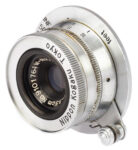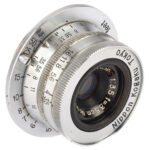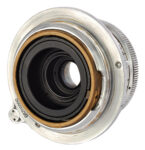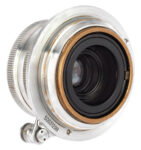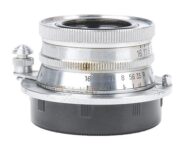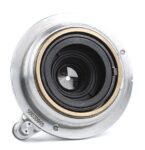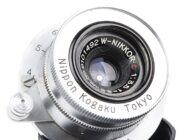Nippon Kogaku W-Nikkor·C 35mm F/3.5 LSM
Wide-angle prime lens • Film era • Discontinued
- Announced:
- · 1949
- Production status:
- ● Discontinued
- Country of design:
- · Japan
- Original name:
- · Nippon Kogaku W-NIKKOR·C 1:3.5 f=3.5cm
- Class:
- · Slow full-frame wide-angle prime lens
- System:
- · Nicca/Yashica (1942)
Specification
| Optical design: | |
| 35mm full frame | |
| 35mm | |
| F/3.5 | |
| 4 elements in 3 groups (Tessar) | |
| Leica screw mount | |
| 63.4° (35mm full frame) | |
| Diaphragm mechanism: | |
Diaphragm type: | Manual |
Aperture control: | Aperture ring |
| 8 (eight) | |
| Focusing: | |
Coupled to the rangefinder: | Yes |
| 3.5 ft. (~1.05m) | |
Focusing modes: | Manual focus only |
Manual focus control: | Focusing lever |
| Physical characteristics: | |
| 150g | |
| <No data> | |
| Accessories: | |
| Screw-type 34.5mm | |
| AS-34.5 - Snap-on round | |
| AN-34.5 - Screw-type round |
Source of data
- Combining high speed with high resolution. Nikkor lenses for Nikon cameras, and other fine 35's booklet.
Manufacturer description #1
This lens is a highly precision-ground lens with a much shorter focal length than the standard 50 mm lens. It takes in a much wider field. The angle of field is 30% greater. Photographers use this lens where the distance between subject and camera is limited and insufficient to show the entire desired subject on the negative. It is excellent for photographing tall buildings or large groups. With such a short focal length lens the depth of field covers a comparatively wide field at fairly wide apertures. For example, with an opening of f/6.3 focused at 23 feet, sharp focus may be obtained on objects from about 10 feet to infinity. This is a universal setting and quick shots can be taken easily when shooting subjects where stopping to focus would be inconvenient. This setting is used for any scene where time does not permit refocusing and resetting of the aperture before each shot. It is especially important to use the universal viewfinder with this lens.
Manufacturer description #2
Picture angle: 62". Click-stops to f/22. Focuses to 3.5ft. or 1m. in meter calibration. Attachment size: Slip-on outer diameter 36mm, Screw-in diameter 34.5mm, P=0.5. Supplied with snap-on front cap 34.5mm, screw-on rear cap L and leather case.
From the Nikon Journal (Vol. 3, No. 3, March 31st, 1986)
This was the first SM wide angle lens developed by N-K. The four element three group TESSAR derivative appeared in 1949 for sale with the NICCA Type III. The triplet design was quite similar to the formula of the LEITZ 3.5/3.5 ELMAR. Angle of view was 62 degrees; near focus was 3.5 feet. Two optically identical versions are known. The earliest has a chrome plated brass rotary mount without front accessory threads. Only push on 36mm accessories, lens caps, hoods, etc. can be used. Serial number batches are 910XXX and 426XXX. Minimum f stop was f16. Earlier lenses are marked "Tokyo" and often have a separate serial number 5003XXX engraved on the rear of the lens mount. The purpose of this second number remains unknown. A plausible explanation is that the optics and mounts are from different production batches and were assigned separate numbers; the mount number used the system whereby the first two digits represent the year of production and the second two represent the month. Certain 5 and 13.5 cm lenses carry similar serial numbers on the front. The second version has a chrome plated brass rotary mount with a black f stop ring and 34.5mm threaded front ring. All are engraved "Japan" and have an improved coating. Serial number range is 435XXX-443XXX. Minimum f stop was f22. An exquisitely rare reversing 34.5mm snap on lens hood, AC518, was provided for the later lenses. Both versions were available with a fitted leather case. The earlier model used a chrome or black 36mm push on front cap. The later model was supplied with a 34.5mm snap on front cap. A standard black plastic unmarked 39mm rear cap came with the late version while a dull chrome plated brass rear cap, often marked "Made in Occupied Japan", is often found on the early model. Both versions were produced in large quantities and are easy to locate in fine condition with appropriate caps and case. Early on a chrome plated, parallax corrected to three feet, optical viewfinder was available. Early units may be engraved "Tokyo" on the rear whiIe later production is marked "Japan". Sometimes an "L" is found on the foot of the viewfinder. The last finder provided was a black non parallax corrected Albada reflecting design much superior in performance. It is a prized user's piece and is rather difficult to obtain in mint condition.
From the editor
6451 units with the Leica screw mount were produced.
Note that this Leica screw mount version uses 34.5mm screw-in filters, while the Nikon S-mount version accepts 43mm screw-in (or Series VII) filters.

